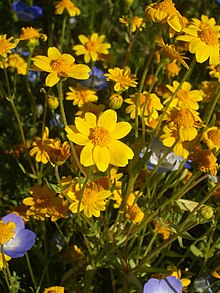|
Lasthenia
Lasthenia, commonly known as goldfields, is a genus of flowering plants family Asteraceae. The genus is named after Lasthenia of Mantinea, a cross-dressing female pupil of the ancient Greek philosopher Plato. DescriptionThe goldfield genus comprises annual (rarely perennial) herbs that are either glabrous or hairy. Stems are typically branched and erect, attaining a height of less than 60 cm (24 in). Their opposite leaves, up to 20 cm (8 in) in length, have entire margins and pinnate venation. Inflorescences are characterized by solitary heads (sometimes in cymes), with phyllaries free or partly fused. The receptacle may present as naked and narrowly conic to hemispherical. The normally yellow ray florets may number 4 to 16, and the ligules are typically yellow as well. The numerous disk florets typically have yellow, 5-lobed corollae. Anther tips manifest as acuminate to triangular. Style tips may be triangular or round and are typically hair-tufted. Fruits are less than 5 mm (0.2 in) across, cylindric to obovoid in shape, and black or gray in color. The pappus may present awns or scales, or infrequently neither. The genus is mostly cross-pollinated, with some insects serving as pollinators.[1]  Ecology and horticultureGoldfield species occur over a range of habitat, such as meadows, shrubland and open forest, but tend towards semiarid conditions. They are commonly found at ephemeral pools and are important plants in coastal regions. They are visited by Sciaridae fungus gnats for nectar, and it is possible that these animals are key pollinators at least for Contra Costa Goldfields (L. conjugens). In horticulture, most make hardy ornamental plants, suitable for flower-beds or borders. Autumn is the best time for sowing the seed, but it may also be sown early in the spring.[2] Species There are a total of eighteen species, seventeen are endemic to North America and one species is only found in Chile. Of the seventeen species found in North America, most are endemic to California.
References
|
||||||||||||||||||||||||||||||||||||||
